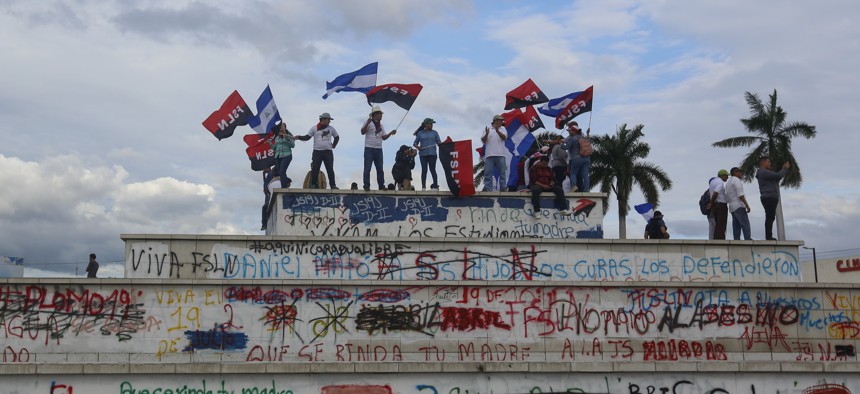
Government supporters wave Sandinista flags on top of the Metro Center roundabout during a pro-government march in Managua, Nicaragua, Wednesday, Sept. 26, 2018. AP Photo/Alfredo Zuniga
Nicaragua’s Deepening Crisis Will Send More Refugees Northward
Political and economic unrest in Nicaragua could stoke the flames in a region where insecurity has forced tens of thousands to flee in recent years.
Not long ago Nicaragua seemed to be an island of calm in an otherwise turbulent corner of the world. The country was one of the poorest in the hemisphere and long ruled by a leftist autocrat and his wife, but its economy was plugging along and its streets were peaceable, particularly in comparison to its Northern Triangle neighbors—El Salvador, Guatemala, and Honduras. But now it is coping with its own political and economic crisis. What happened? How did conditions spiral so quickly?
What Triggered the Crisis
Until last year, Nicaragua was a tourism hot spot and home to one of Latin America’s fastest-growing economies, ticking upward at about 5 percent per year. President Daniel Ortega, who for years had consolidated power through nepotism and graft, maintained popular support by administering welfare programs for the nation’s poor. Things began to turn, however, after longtime benefactor Venezuela pulled its aid in 2017 amid an economic collapse of its own. As Caracas turned off the spigot, which was running at hundreds of millions of dollars a year, Nicaragua was forced to cut back.
The spark that lit the fuse came this April, when Ortega, a former Marxist revolutionary now in his fourth term, announced he would slash social security benefits as a cost-cutting measure. Backed by business leaders, an outraged public took to the streets by the hundreds of thousands to demand Ortega’s resignation, which prompted a crackdown by government and paramilitary forces that has left hundreds dead and many more injured.
The World Reacts
The violence, which peaked over the summer, has drawn widespread condemnation from human rights groups, regional organizations, and foreign governments, including the United States. The United Nations has accused the Ortega administration, the military, and the police of human rights violations, including torture and extrajudicial killings. The Trump administration has sanctioned several senior Nicaraguan officials, and in November it characterized Nicaragua along with Cuba and Venezuela as a “troika of tyranny.” The Catholic Church, meanwhile, has tried and failed to broker talks between Ortega and the opposition.
A Derailed Economy
The instability has rocked Nicaragua’s developing market, which is now expected to contract by 6 percent this year. The workforce has shrunk by 10 percent, and panicky investors have pulled out some $1 billion in capital.
The tourism sector, once a pillar of growth, has been particularly hard hit, with many hotels and restaurants closing or cutting back service. The U.S. State Department continues to discourage Americans from traveling to Nicaragua because of violent crime and civil unrest.
What’s Next
So far, Ortega shows no signs of relinquishing power. He has refused to step down before elections in 2021, when many analysts fear he will rig the vote to instate his wife, Rosaria Murillo, as a proxy ruler.
The U.S. Congress is weighing a set of broader sanctions that would, among other things, place restrictions on international lending to Nicaragua. However, some analysts caution that upping the financial pressure on the regime could cause the political situation to deteriorate further and feed instability in an already beleaguered region.
Given the turmoil in the Northern Triangle, tens of thousands of Nicaraguans are fleeing south for Costa Rica. Migrant flows could increase early next year, when thousands of Nicaraguans living in the United States could lose temporary protected status and be required to leave or find an alternative legal means to stay in the country.
This piece, first published by the Council on Foreign Relations, is used with permission.



